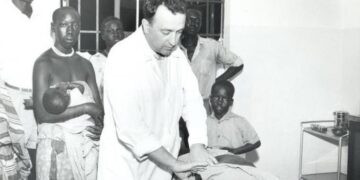By DR. MIRIAM LAKER-OKETTA
In the realm of medical emergencies, few conditions rival the devastation caused by stroke. This silent threat strikes millions of individuals worldwide, leaving lasting physical and cognitive impairments in its wake. With an alarming rise in stroke cases, understanding this condition and taking proactive measures becomes paramount. In this article, we will delve into the world of stroke, shedding light on its causes, symptoms, prevention methods and appropriate responses.
Understanding Stroke
————————–
Stroke occurs when the blood supply to the brain is interrupted or reduced, depriving it of essential oxygen and nutrients. This can happen either due to a blocked blood vessel (ischemic/loss of oxygen stroke) or a ruptured blood vessel, causing bleeding into the brain (hemorrhagic/bleeding stroke). Regardless of the type, the resultant damage to brain cells can have a profound impact on various bodily functions, including movement, speech and cognitive abilities.
THE WARNING SIGNS
——————————–
Recognizing the warning signs of stroke can significantly increase the chances of an individual receiving timely medical assistance, potentially reducing the severity of the condition. Common signs include: sudden weakness or numbness on one side of the face, arm, or leg and difficulty in moving the limbs, difficulty in speaking or understanding speech, blurred vision, dizziness and severe headache. Remember the acronym F.A.S.T. – Face, Arms, Speech, Time. If you notice any of these signs, act quickly! Rush the person to a medical facility. Sometimes the stroke may progress slowly with the signs and feels gradually increasing.
PREVENTING STROKE
——————————
While stroke can be a life-altering event, adopting certain lifestyle modifications can greatly reduce the risk. Leading a healthy lifestyle is crucial, incorporating regular exercise; even walking briskly for half an hour daily, maintaining a balanced diet, controlling high blood pressure, managing stress levels, minimizing alcohol intake, and avoiding tobacco use. Additionally, individuals with pre-existing health conditions such as; sickle cell disease, diabetes or irregular heart rhythms must effectively manage them, seeking regular medical check-ups.
RESPONDING TO STROKE
———————————
Time is of the essence when it comes to stroke response. For every minute without proper medical intervention, an individual’s chance of recovery diminishes. If you suspect someone is having a stroke, call emergency services immediately. While waiting for assistance, note the time the symptoms started as this information is crucial for treatment decisions. Note: It is essential not to give the person experiencing a stroke anything to eat or drink, as this could interfere with medical procedures and the person can easily choke since their swallowing mechanism may have been affected by the weakness of the nerves. Be supportive, reassured and ensure the patient stays as calm as possible. If possible, do not transport the individual to the hospital by yourself. Call for an ambulance. When the option is not available like in many low-income countries, take the person yourself as quickly as possible.
ROAD TO RECOVERY
——————————
Surviving a stroke is just the beginning of a challenging journey towards recovery. Rehabilitation programs play a vital role in restoring lost functions and enhancing overall quality of life. These programs primarily focus on physical therapy, speech therapy, occupational therapy and psychological support. Patience, perseverance, and unwavering support from loved ones are vital during this phase. Some people recover faster than others. Keep receiving the requisite care and following medical instructions. Stroke is a formidable force that can alter lives in an instant. However, by raising awareness of its signs, adopting preventive measures and responding promptly, we can minimize its impact and potentially save lives. Stay informed, take proactive steps and together, let us triumph over this silent threat!
















